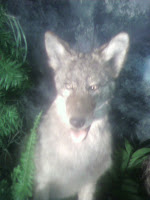Unfortunately
not everybody has the perfect setup for a free ranged flock, but here are a few
things that can make free ranging safer for your birds and less stressful for
you.
Know Your Predators
Each
area has its own kinds of predators. Talk to your local wildlife experts to
find out what predators are the most common in your area. Some predators like owls,
raccoons, skunks and opossums primarily hunt from dusk to dawn, and simply
making sure your flock is secured in its coop during those times can mean fewer
losses.
(Coyote Photo courtesy of "Mellabella")
Fox,
coyotes, weasels, hawks, bobcats, mountain lions/cougars, eagles and others are
primarily daytime predators. Weasels are generally found around areas with
lakes, streams and other sources of water. Weasels can fit in through spaces
barely over an inch in diameter, and surprisingly, pose a higher risk to cooped
birds than to those that are free ranging. If you do not have any bodies of
water, weasels may not be a concern for you.
(Weasel Photo courtesy of "Stonykill")
Plan
your set-up around your local predators. The methods that work for chicken owners in the
Rockies will be totally different than those successfully employed by those in the
coastal regions and so-on.
The Livestock
Guardian Dog (LGD)
Nothing
deters predators both in the air and on the ground like the presence of a dog!
It goes without saying that most dogs need a bit of training before being set
loose with your flock, but any time you spend training your dog for this job
will be well worth the effort!
(Photo courtesy of Kate Saunders - my sis!)
Certain
breeds have been bred up just for the purpose of watching over flocks. The
Great Pyrenees, Burmese Mountain Dog, Komondor, Maremma Sheep Dog and German
Shepherd Dog are just a few of those breeds. These dogs often need surprisingly
little training to become wonderful LGDs quite quickly.
(Photo Courtesy of Aoxa of Les Farms)
Notoriously
high-strung dog breeds (like terriers) and those that love to truly herd
animals (like the Australian Shepherd and Border Collie) may need more training
than other dogs to teach them to ignore their desire to chase, hunt or herd
your chickens.
(My LGD, Brandy Ann - an Olde Victorian Bulldogge)
That
said, almost any breed of dog can be trained for the task. Dogs –
especially those that have a calm nature and a desire to please - will enjoy
having this job and the feeling of importance they will get from keeping your
birds safe.
As a side note, donkeys and llamas are also known for deterring ground predators.
Encourage the Crows
That’s
right, the crows! Crows are wonderful at chasing away aerial predators like
hawks. Encouraging crows to make nests nearby and hang out at your place may
not be great for your vegetable garden, but it is wonderful for enhancing the
safety of your flock! They don’t call it a “murder” of crows for nothing!
Electric Poultry Netting
For
daytime ground predators, electric poultry netting is a great way to go.
Manufacturers of this kind of poultry netting will tell you that a properly
installed fence will deter a small bear. Coyotes, foxes and other
ground-dwellers tend to stay well away after getting zapped a time or two.
Don’t
worry – it won’t hurt your birds. Yes – they’ll get zapped, but unless they
somehow manage to become entrapped in the netting, it will not do anything more
than give them a bit of a shock.
Most
poultry netting is very easy to install and very easy to move about to change
the areas you allow your flock to range. While it may not seem like true free
ranging if there is a perimeter around your flock, this fencing is surprisingly
affordable and multiple sections may be put together to fence off large areas.
Keep a Rooster
Roosters
are the most natural form of flock protection there is. While the hens go about
their business searching for bugs and tending their chicks, roosters keep their
eyes open for potential danger. If danger is present, a rooster will often make
a vocal call that the rest of the flock recognizes as a warning. This will send
the rest of the birds running for cover.
(Gunnar - my Swedish Flower Hen rooster)
Roosters
have been known to race right into the face of danger when a hen is under
attack by a predator, sacrificing himself to save his flock members.
Not
everyone can keep a rooster – check with your local ordinances to see if they
are allowed where you live.
Provide Hiding
Places
Something
as simple as a piece of plywood leaning up against a solid fence or an old dog
house can provide your flock with good hiding places from aerial predators.
Some even make small, makeshift tents for their birds to hide under – these also
provide a good source of shade on those hot summer days.
(Photo courtesy of "armorfirelady")
Just
having areas that allow your flock to “vanish” at the first sight of a distant
hawk can reduce the number of fly-bys these predators make.
Fly a Flag… Or 10…
Some
have found that placing a few flapping flags around the perimeter of the free
ranging area can deter eagles, hawks and owls. Be sure to move them about the
yard every so often so predators don’t become used to them.
Set Live Traps
If
you have persistent predators like raccoons, consider investing in a “Have-A-Hart”
live trap or two. Just don’t make these critters another farm’s problem. If you
choose to release them, be sure it is far, far, faaaaaarrr away from other
poultry farms!
Don’t Keep Food Out
Leaving
food about only attracts vermin. Find a good place away from your flock to lock
up uneaten feed until morning.
Domestic Dangers
Some
of the most deadly predators to your flock are stray domesticated dogs. Know
what animals your neighbors have and make sure there is no way for their loose
dogs to come on to your property.
And Lastly –
Many
old timers will tell you they have suffered the worst losses to their flocks
when those birds were locked up – either in the coop at night or in a run where
they could not escape a predator that found its way in. In a confined setting,
your birds can not escape.
While
it is true that a coyote or fox may kill a few birds from a free ranged flock,
usually the rest of the flock will get into trees or hide in the mayhem. If a
fox digs into your run, your losses could be much greater as the rest of the flock
can not escape.
If
you must keep your birds locked up all day, make absolutely certain both your
coop and run are constructed like Ft. Knox. Digging predators will try to dig
under your fences. Coyotes can chew through chicken wire and raccoons can
sometimes bend it just enough to reach in and grab the head or leg of an
unsuspecting chicken. Weasels can get through holes barely over an inch in
diameter and can devastate a flock in no time flat.
Know
what predators pose the biggest dangers and design your coop and run to keep
them out.
***
You
will find that different chicken keepers will have very different views on free
ranging. Having read many different views on free ranging prior to setting my
flock loose, I had a lot of concerns.
Even
after almost a year since my flock started free ranging, I still worry about
the day I will experience losses from predators. I am sure it will happen – it is
only a matter of time.
Yet
– over this past year I have lost a
number of birds… to injury and one to an intestinal obstruction. None have been
lost to predators (knocking on wood like
crazy right now).
I
am lucky to have a wonderful dog who enjoys playing “Mamma” to my flock. The
farm we are renting is on primarily cleared land, so predators like coyotes and
foxes tend not to stray so far out of the tree line. None of the neighbors
(other than our landlords) have dogs that roam, and the landlord’s dog seems to
be fine with the chickens. We have seen opossum, but have made every effort to
deter night predators by building our coops to keep them out. Last year we had
a visit from a hawk when my first batch of chicks were young. Since that time,
a large murder of crows has taken up residence in the area and I have not seen
hawks near the house since.
My
flock thrives with all the freedom they have, and I love watching happy
chickens exploring the acreage around the farm. When the day comes that I do lose a bird to a
predator, I know it will be hard… but I also know that the bird spent its days
enjoying freedom, exercise and all the bugs and plants it wanted. And in my own
attempt to find the most natural approach to keeping my flock, the ability to
allow my flock to free range makes me happy.
I
know not everybody is able to free range their flock all day for one reason or
another and that is fine too. We all have different situations and we must do
what we truly believe is best for our birds.
Happy
Chickening!
- Leigh































